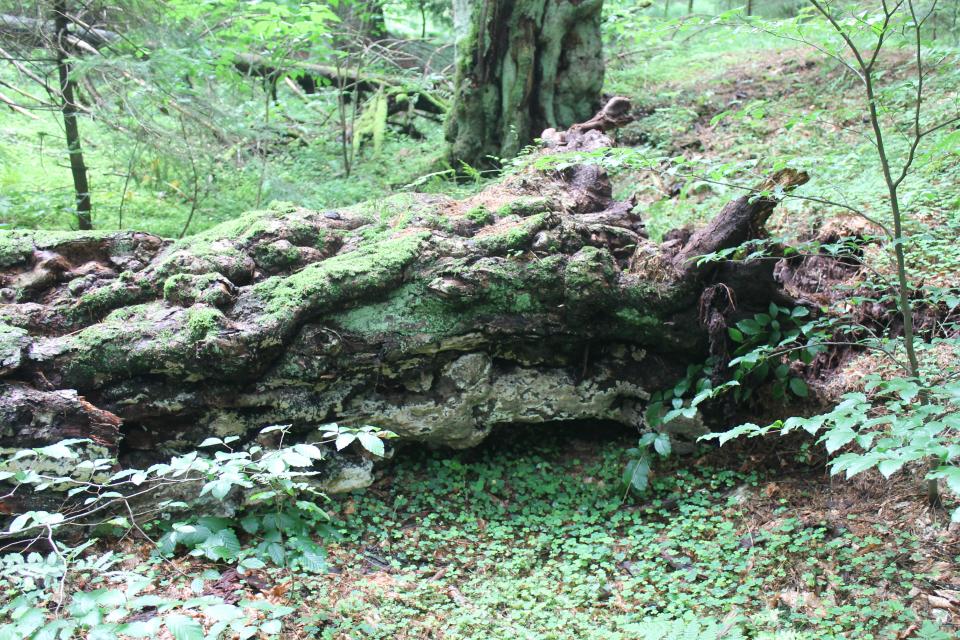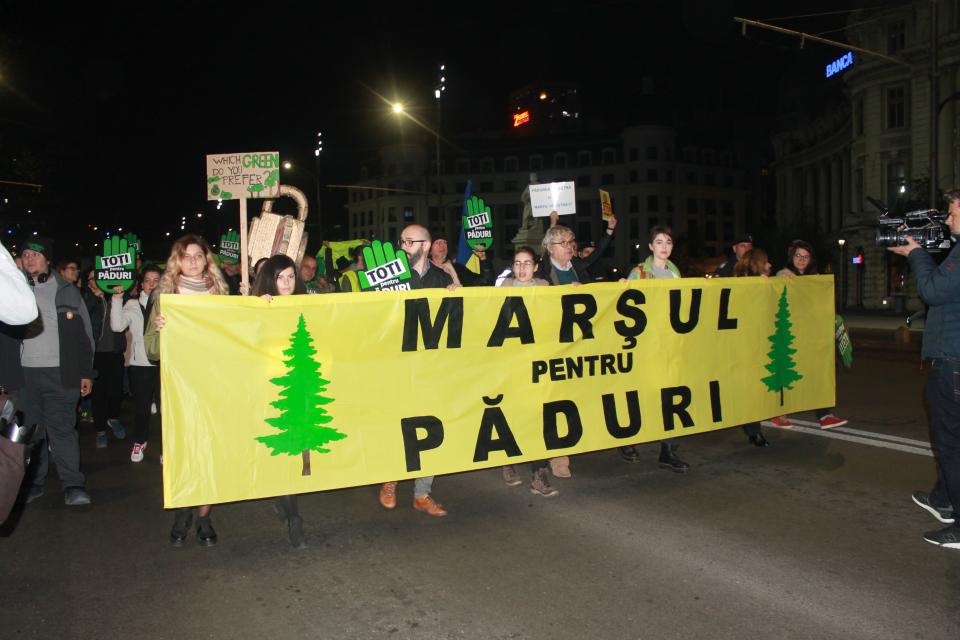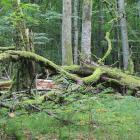Remote sensing technologies and high-resolution satellite imagery are techniques currently used to map virgin forest across the Carpathian Mountains. Protecting Europe’s remaining old-growth forests is considered among the most efficient strategies in mitigating climate change. As these forests are an essential source of information about the structure, natural processes, and general functioning of intact ecosystems, their protection is considered by many natural scientists as crucial. The imaginary of virgin forests as untouched wilderness devoid of humans is central in many environmental campaigns and in the public discourse, but the idea can hardly be sustained with regards to the culturally rich landscapes of the Carpathians.

Dead wood is a recognizable feature of old-growth beech forests.
Dead wood is a recognizable feature of old-growth beech forests.
Photograph by George Iordăchescu, 2015.
 This work is licensed under a Creative Commons Attribution 4.0 International License.
This work is licensed under a Creative Commons Attribution 4.0 International License.
The first attempts to map old-growth forests in the Southern Carpathian Mountains of Romania were those of forest management officers, working in the early decades after World War II, a period of an extensive assessment of the country’s natural resources. As the strict protection of nature was considered economically inefficient by the communist regime, a complete study and inventory would have to wait at least half a century more in Romania. The Inventory and Strategy for Sustainable Management and Protection of Virgin Forests in Romania is today regarded among environmentalists and conservation practitioners as a founding moment in the protection of virgin forests. The project, known as the PIN-Matra study, started in 2001 and enjoyed the generous support of the Dutch Ministries of Agriculture, Nature and Food Quality, and Foreign Affairs. It was executed jointly by the Romanian Forest Research and Management Institute and the Royal Dutch Society for Nature Conservation and its conclusions were published in 2005. Largely a desktop study, the most important results of the collaboration between Dutch and Romanian forestry scientists were a map of 218,000 hectares of untouched virgin forest, a final definition of what constitutes a virgin forest, and a set of policy recommendations. The report was issued with some urgency, due to the rapid forest degradation in the Carpathians, triggered by postsocialist land restitution that resulted in rampant illegal logging.

Natural succession characterizes the ecological dynamics of a virgin forest.
Natural succession characterizes the ecological dynamics of a virgin forest.
Photograph by George Iordăchescu, 2018.
 This work is licensed under a Creative Commons Attribution 4.0 International License.
This work is licensed under a Creative Commons Attribution 4.0 International License.
While previous scientific inquiries used terms such as old-growth or primeval and acknowledged the role of local communities for their historical protection, the PIN-Matra study opted exclusively for the use of “virgin forests,” thus disregarding any human involvement in their development. Their species composition, their structure and forest dynamics, but also the issue of scale were important factors in this inventory. The study has had great importance for the protection of virgin forests; it has been used and abused ever since in multiple environmental reports, press releases, and official documents and invoked in public awareness campaigns.
In 2012 a ministerial order became the first legal tool for virgin-forest protection, as it used the recommendations of the PIN-Matra inventory. Namely, naturalness and size were the two criteria used to set clear boundaries between what needed to be considered untouched nature and what could be managed according to conventional forestry practices, rural development programs, and other systems governing human use of forests. Further, in 2016, another ministerial order established a national catalog for virgin-forest protection. It also designated forestry experts and conservation scientists as the only legitimate actors who could identify and validate virgin forests for strict protection. While knowledge production about virgin forests became an expert operation, public support for the protection of these charismatic ecosystems culminated in nation-wide environmental movements.

People protesting in Bucharest for virgin-forest protection, November 2019.
People protesting in Bucharest for virgin-forest protection, November 2019.
Photograph by George Iordăchescu, 2019.
 This work is licensed under a Creative Commons Attribution 4.0 International License.
This work is licensed under a Creative Commons Attribution 4.0 International License.
Numbers and emotional figures have great importance for the success of public environmental campaigns. Frequently abstract values are uncritically circulated to ensure citizens’ sympathy, outrage, or involvement. According to the state’s way of seeing, virgin forests are not aggregated numbers, but fragmented plots recorded under a unique attribute number. The catalog records nothing about their ecological richness and biological diversity, both features used as key arguments for their protection in public discourse and scientific literature.
In 2017 Greenpeace worked together with international experts on an updated study of the spatial distribution of virgin forests. Surprisingly, 160,000 hectares of potential virgin forest were discovered on top of those mapped more than a decade before. The scientists used open-source data provided by Sentinel II missions from 2015 to 2016, and their methodology consisted of a spectral analysis of existing vegetation. Even if the study excluded traces of recent timber extraction and human disturbances in the canopy, unpaved roads and footpaths were not excluded as the imagery resolution did not allow for that. Traces of transhumance and other traditional uses were thus blanked out. Why should this matter? The argument is important when remembering that the most circulated stereotype about virgin forests is that they are “untouched.” Politically this becomes a dangerous plea for their protection. Without a history, the forests are up for grabs and can become central elements of fortress-conservation projects. When strict protection regimes are instituted, the livelihoods of traditional users like mushroom pickers or herders are disrupted; they cannot claim any rights to forest allegedly “untouched.” Although scientists and forest experts had good intentions and worked towards pressuring the government to put a halt to illegal logging, maps still remain powerful technologies with which to claim land for conservation.

The protection of old-growth forests represents a pressing issue for EU environmental politics.
The protection of old-growth forests represents a pressing issue for EU environmental politics.
Photograph by George Iordăchescu, 2019.
 This work is licensed under a Creative Commons Attribution 4.0 International License.
This work is licensed under a Creative Commons Attribution 4.0 International License.
The implication of this discovery poses serious questions regarding the role of different methodologies in making virgin forests legible. It teaches us that maps are a result of a whole set of corrections informed by scientists’ expertise. Not only can this narrowing of vision potentially produce further environmental injustice, but it also obliterates a rich environmental history as a new dichotomous system (wild/not wild) of classifying nature becomes the norm of the scientific gaze.
How to cite
Iordăchescu, George. “Becoming a Virgin Forest: From Remote Sensing to Erasing Environmental History.” Environment & Society Portal, Arcadia (Spring 2021), no. 10. Rachel Carson Center for Environment and Society. doi:10.5282/rcc/9254.
ISSN 2199-3408
Environment & Society Portal, Arcadia
 This work is licensed under a Creative Commons Attribution 4.0 International License.
This work is licensed under a Creative Commons Attribution 4.0 International License.
2021 George Iordăchescu
This refers only to the text and does not include any image rights.
Please click on an image to view its individual rights status.
- Egerer, Herald. “Wilderness Protection under the Carpathian Convention.” In Wilderness Protection in Europe, edited by Kees Bastmeijer, 222–24. Cambridge: Cambridge University Press, 2016.
- Goldman, Mara J., Paul Nadasdy, and Matthew D. Turner, eds. Knowing Nature: Conversations at the Intersection of Political Ecology and Science Studies. Chicago: Chicago University Press, 2011.
- Knorn, Jan, Tobias Kuemmerle, Volker C. Radeloff, William S. Keeton, Vladimir Gancz, et al. “Continued Loss of Temperate Old-Growth Forests in the Romanian Carpathians despite Increasing Protected Area Network.” Environmental Conservation 40, no. 2: 182–93.
- Miu, Iulia V., Laurentiu Rozylowicz, Viorel D. Popescu, and Paulina Anastasiu. “Identification of Areas of Very High Biodiversity Value to Achieve the EU Biodiversity Strategy for 2030 Key Commitments.” PeerJ 8 (2020): e10067.
- Neumann, Roderick. “Stories of Nature’s Hybridity in Europe: Implication for Forest Management in the Global South.” In The Social Lives of Forests: Past, Present, and Future of Woodland Resurgence, edited by Susanna Hecht et al., 31–44. Chicago: Chicago University Press, 2014.
- Smejkal, Geza Matthias, Constantin Bandiu, and Dagmar Vişoiu-Smejkal. Banater Urwälder: ökologische Untersuchungen in Rumänien. Temeswar: Mitron Verlag, 1997.
- Veen, Peter, Josef Fanta, Ivan Raev, Iovu-Adrian Biriş, Jacques de Smidt, and Bert Maes. “Virgin Forests in Romania and Bulgaria: Results of Two National Inventory Projects and Their Implications for Protection.” Biodiversity Conservation 19 (2010): 1805–19.








